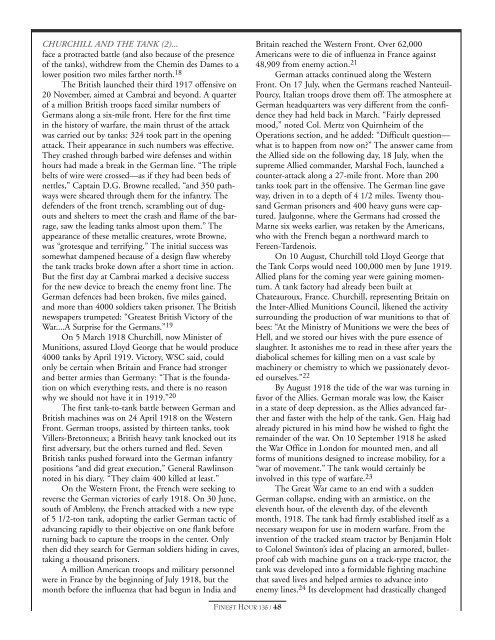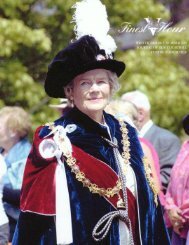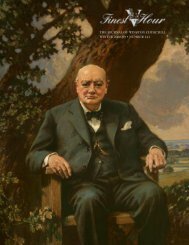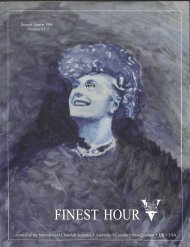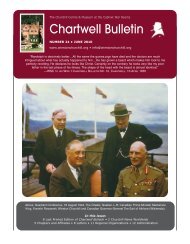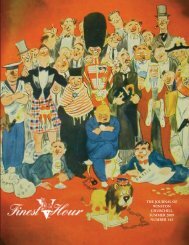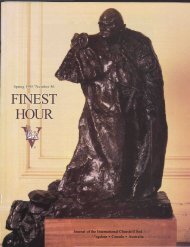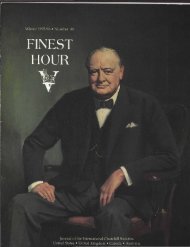You also want an ePaper? Increase the reach of your titles
YUMPU automatically turns print PDFs into web optimized ePapers that Google loves.
CHURCHILL AND THE TANK (2)...face a protracted battle (and also because of the presenceof the tanks), withdrew from the Chemin des Dames to alower position two miles farther north. 18The British launched their third 1917 offensive on20 November, aimed at Cambrai and beyond. A quarterof a million British troops faced similar numbers ofGermans along a six-mile front. Here for the first timein the history of warfare, the main thrust of the attackwas carried out by tanks: 324 took part in the openingattack. Their appearance in such numbers was effective.They crashed through barbed wire defenses and withinhours had made a break in the German line. “The triplebelts of wire were crossed—as if they had been beds ofnettles,” Captain D.G. Browne recalled, “and 350 pathwayswere sheared through them for the infantry. Thedefenders of the front trench, scrambling out of dugoutsand shelters to meet the crash and flame of the barrage,saw the leading tanks almost upon them.” Theappearance of these metallic creatures, wrote Browne,was “grotesque and terrifying.” The initial success wassomewhat dampened because of a design flaw wherebythe tank tracks broke down after a short time in action.But the first day at Cambrai marked a decisive successfor the new device to breach the enemy front line. TheGerman defences had been broken, five miles gained,and more than 4000 soldiers taken prisoner. The Britishnewspapers trumpeted: “Greatest British Victory of theWar....A Surprise for the Germans.” 19On 5 March 1918 <strong>Churchill</strong>, now Minister ofMunitions, assured Lloyd George that he would produce4000 tanks by April 1919. Victory, WSC said, couldonly be certain when Britain and France had strongerand better armies than Germany: “That is the foundationon which everything rests, and there is no reasonwhy we should not have it in 1919.” 20The first tank-to-tank battle between German andBritish machines was on 24 April 1918 on the WesternFront. German troops, assisted by thirteen tanks, tookVillers-Bretonneux; a British heavy tank knocked out itsfirst adversary, but the others turned and fled. SevenBritish tanks pushed forward into the German infantrypositions “and did great execution,” General Rawlinsonnoted in his diary. “They claim 400 killed at least.”On the Western Front, the French were seeking toreverse the German victories of early 1918. On 30 June,south of Ambleny, the French attacked with a new typeof 5 1/2-ton tank, adopting the earlier German tactic ofadvancing rapidly to their objective on one flank beforeturning back to capture the troops in the center. Onlythen did they search for German soldiers hiding in caves,taking a thousand prisoners.A million American troops and military personnelwere in France by the beginning of July 1918, but themonth before the influenza that had begun in India andBritain reached the Western Front. Over 62,000Americans were to die of influenza in France against48,909 from enemy action. 21German attacks continued along the WesternFront. On 17 July, when the Germans reached Nanteuil-Pourcy, Italian troops drove them off. The atmosphere atGerman headquarters was very different from the confidencethey had held back in March. “Fairly depressedmood,” noted Col. Mertz von Quirnheim of theOperations section, and he added: “Difficult question—what is to happen from now on?” The answer came fromthe Allied side on the following day, 18 July, when thesupreme Allied commander, Marshal Foch, launched acounter-attack along a 27-mile front. More than 200tanks took part in the offensive. The German line gaveway, driven in to a depth of 4 1/2 miles. Twenty thousandGerman prisoners and 400 heavy guns were captured.Jaulgonne, where the Germans had crossed theMarne six weeks earlier, was retaken by the Americans,who with the French began a northward march toFereen-Tardenois.On 10 August, <strong>Churchill</strong> told Lloyd George thatthe Tank Corps would need 100,000 men by June 1919.Allied plans for the coming year were gaining momentum.A tank factory had already been built atChateauroux, France. <strong>Churchill</strong>, representing Britain onthe Inter-Allied Munitions Council, likened the activitysurrounding the production of war munitions to that ofbees: “At the Ministry of Munitions we were the bees ofHell, and we stored our hives with the pure essence ofslaughter. It astonishes me to read in these after years thediabolical schemes for killing men on a vast scale bymachinery or chemistry to which we passionately devotedourselves.” 22By August 1918 the tide of the war was turning infavor of the Allies. German morale was low, the Kaiserin a state of deep depression, as the Allies advanced fartherand faster with the help of the tank. Gen. Haig hadalready pictured in his mind how he wished to fight theremainder of the war. On 10 September 1918 he askedthe War Office in London for mounted men, and allforms of munitions designed to increase mobility, for a“war of movement.” The tank would certainly beinvolved in this type of warfare. 23The Great War came to an end with a suddenGerman collapse, ending with an armistice, on theeleventh hour, of the eleventh day, of the eleventhmonth, 1918. The tank had firmly established itself as anecessary weapon for use in modern warfare. From theinvention of the tracked steam tractor by Benjamin Holtto Colonel Swinton’s idea of placing an armored, bulletproofcab with machine guns on a track-type tractor, thetank was developed into a formidable fighting machinethat saved lives and helped armies to advance intoenemy lines. 24 Its development had drastically changedFINEST HOUR 135 / 48


